ProAssurance Bundle
Who Really Controls ProAssurance Company?
Unraveling the mystery of 'Who owns ProAssurance Company?' is key to grasping its strategic moves and influence in the specialty insurance world. Ownership dictates everything from long-term investments to everyday decisions, making it a critical factor for anyone looking to understand this major player. Founded in 1976, ProAssurance Corporation has evolved from its roots in healthcare professional liability to cover a broader spectrum of risks.
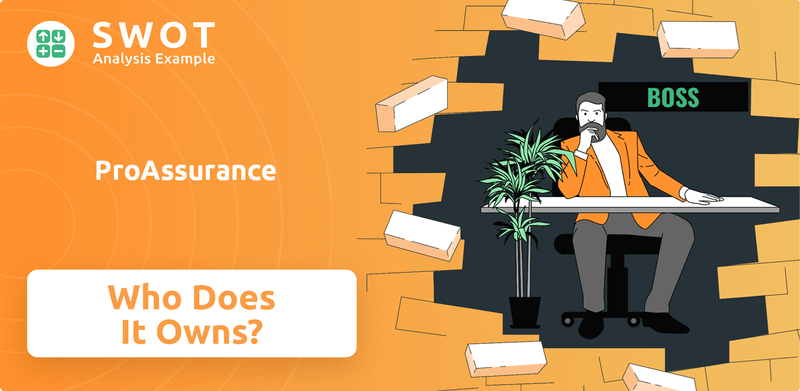
As a publicly traded entity, understanding the ProAssurance SWOT Analysis is crucial. ProAssurance ownership is a mix of institutional investors, mutual funds, and individual shareholders, creating a dynamic environment. This analysis will explore the company's ownership structure, tracing its evolution and highlighting the impact of key investors. Knowing who owns ProAssurance is essential for assessing its past performance, current position, and future potential within the competitive insurance market, including its stock and leadership.
Who Founded ProAssurance?
Understanding the ownership structure of the ProAssurance company starts with its origins. ProAssurance, established in 1976, emerged through the consolidation of several physician-sponsored professional liability insurance companies. This unique beginning shaped its initial ownership, focusing on the needs of healthcare professionals.
The early ownership of ProAssurance was deeply rooted in the medical community. The company's structure was designed to serve the interests of its insured physicians, a common practice among early professional liability insurers. This approach fostered a sense of mutual benefit and aligned the insurer's success with that of its policyholders.
While specific details about the founders' equity splits are not readily available in public records, it's known that the initial ownership involved medical associations and individual physicians. This structure aimed to ensure stability and a long-term commitment to the healthcare sector.
The initial phase of ProAssurance's ownership prioritized the interests of the insured physicians.
This model, common among early professional liability insurers, aimed to align the interests of the insurer with its policyholders.
Early backers included medical associations and individual physicians who supported the formation and growth of these specialized insurance entities.
Agreements such as vesting schedules or buy-sell clauses would have been designed to maintain the company's focus on its core mission.
The founding team's vision of providing dedicated and specialized insurance solutions to healthcare professionals was inherently reflected in this initial distribution of control.
This emphasized stability and long-term commitment over short-term gains.
The initial ownership of ProAssurance, designed to support healthcare professionals, highlights the company's commitment to its core mission. Understanding the early ownership structure provides context for the company's later growth and evolution. For those interested in ProAssurance stock or ProAssurance investors, this historical perspective is key.
- ProAssurance's early ownership was centered on the medical community.
- The structure aimed to align the interests of the insurer and policyholders.
- Early investors included medical associations and individual physicians.
- The focus was on long-term commitment and stability within the healthcare sector.
ProAssurance SWOT Analysis
- Complete SWOT Breakdown
- Fully Customizable
- Editable in Excel & Word
- Professional Formatting
- Investor-Ready Format
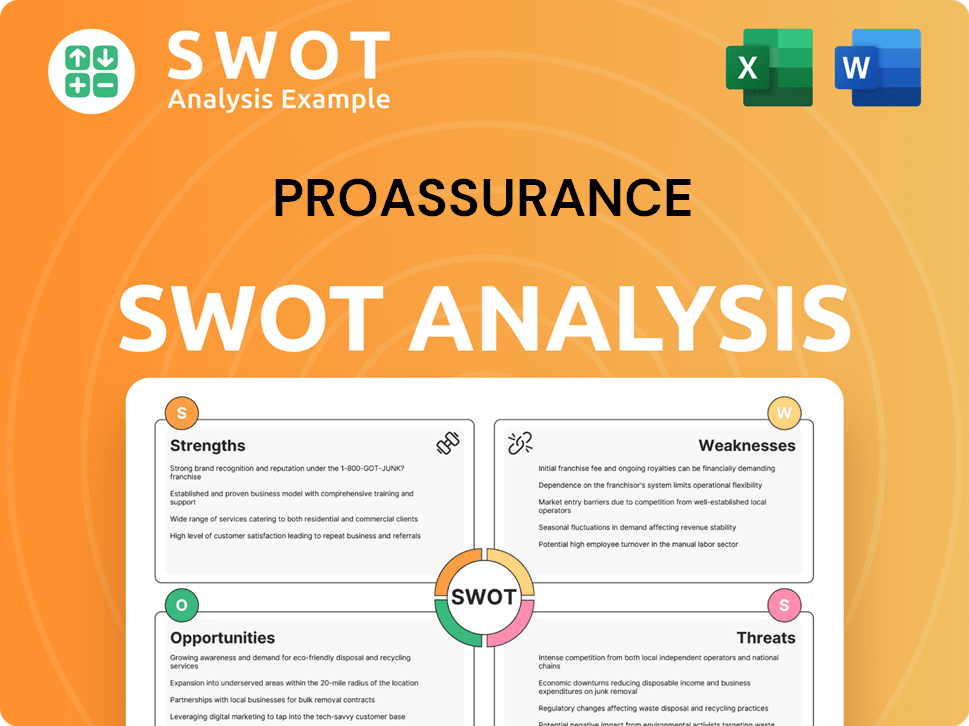
How Has ProAssurance’s Ownership Changed Over Time?
The ownership structure of the ProAssurance company has changed considerably since its inception. Becoming a publicly traded entity marked a significant shift, opening the door for institutional and individual investors. The evolution reflects the company's growth and integration within the broader financial markets. Understanding the ownership dynamics is crucial for assessing the company's strategic direction and market position.
As of early 2025, the ownership of ProAssurance is largely influenced by institutional investors. These entities hold a significant percentage of the outstanding shares, reflecting confidence in the company's long-term prospects. The presence of major institutional shareholders such as The Vanguard Group and BlackRock underscores the company's stability and attractiveness to large-scale investors. Changes in these holdings can be indicators of shifts in market sentiment or strategic decisions.
| Shareholder | Approximate Holdings (as of March 31, 2025) | Notes |
|---|---|---|
| The Vanguard Group, Inc. | Over 10% | Consistently a top institutional holder. |
| BlackRock, Inc. | Significant, but slightly less than Vanguard | Active and passive investment strategies. |
| Other Institutional Investors | Varies | Includes mutual funds and hedge funds. |
Other significant stakeholders include various mutual funds and hedge funds, which adjust their positions based on market conditions. The collective ownership of the board of directors and executive officers, while smaller, aligns their interests with the company's performance. Changes in major shareholdings, particularly by large institutional investors, can influence company strategy and governance. For more insights into the company's strategic direction, consider reading about the Growth Strategy of ProAssurance.
ProAssurance's ownership structure is dominated by institutional investors, such as Vanguard and BlackRock. These major shareholders influence company strategy and governance. Understanding the ownership dynamics is crucial for investors.
- Institutional investors hold a significant portion of ProAssurance stock.
- Vanguard and BlackRock are among the top institutional holders.
- Changes in ownership can signal shifts in strategy.
- Insider ownership aligns interests with company performance.
ProAssurance PESTLE Analysis
- Covers All 6 PESTLE Categories
- No Research Needed – Save Hours of Work
- Built by Experts, Trusted by Consultants
- Instant Download, Ready to Use
- 100% Editable, Fully Customizable
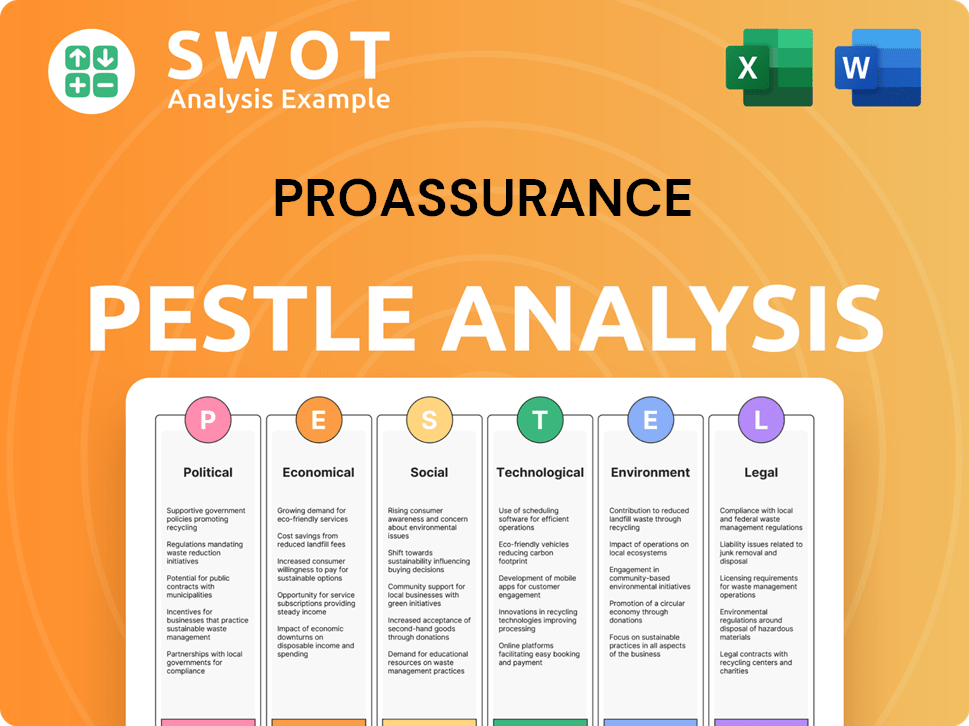
Who Sits on ProAssurance’s Board?
As of mid-2025, the Board of Directors of the ProAssurance company is pivotal in overseeing the company's operations and ensuring its strategic direction. The board is typically composed of a mix of independent directors and those with connections to major shareholders or the company's management. Although specific names and their direct ownership percentages change, the board's composition is designed to provide oversight and strategic guidance. Board members often have extensive experience in the insurance, healthcare, or financial sectors. Independent directors are crucial for maintaining objective decision-making and representing the broader shareholder base. Understanding the composition and influence of the board is essential for investors and stakeholders interested in the ProAssurance ownership structure.
The board's structure reflects a commitment to good corporate governance. The presence of experienced professionals helps in navigating the complexities of the insurance industry. Additionally, the board's composition ensures a balance of perspectives, which is critical for making informed decisions. This balance is particularly important given the company's position in the market and its interactions with various stakeholders, including ProAssurance investors. The board's role is continuously monitored to ensure alignment with best practices in corporate governance, especially given the influence of major institutional investors.
| Board Member | Title | Affiliation |
|---|---|---|
| Michael H. Boguski | Chairman of the Board | Independent Director |
| Ned Rand | President and CEO | ProAssurance |
| William J. O'Brien | Lead Independent Director | Independent Director |
ProAssurance operates under a one-share-one-vote structure, which means each common share grants its holder one vote on matters presented to shareholders, such as the election of directors or approval of corporate actions. This structure ensures that the influence of major institutional investors, such as The Vanguard Group and BlackRock, is directly proportional to their shareholdings. The standard voting structure promotes fairness and transparency in governance. Any significant shifts in the company's performance or strategic direction could potentially trigger increased scrutiny or activism from these large holders, influencing decision-making within the company. For those interested in the company's competitive landscape, further insights can be found in the Competitors Landscape of ProAssurance.
The Board of Directors at ProAssurance plays a crucial role in governance, with a mix of independent and affiliated members. The company operates under a one-share-one-vote system, ensuring proportional influence for shareholders. Understanding the board's composition and voting structure is vital for investors.
- Board members bring expertise from insurance, healthcare, and finance.
- Independent directors ensure objective decision-making.
- Major institutional investors have influence proportional to their holdings.
- No special voting arrangements grant outsized control.
ProAssurance Business Model Canvas
- Complete 9-Block Business Model Canvas
- Effortlessly Communicate Your Business Strategy
- Investor-Ready BMC Format
- 100% Editable and Customizable
- Clear and Structured Layout
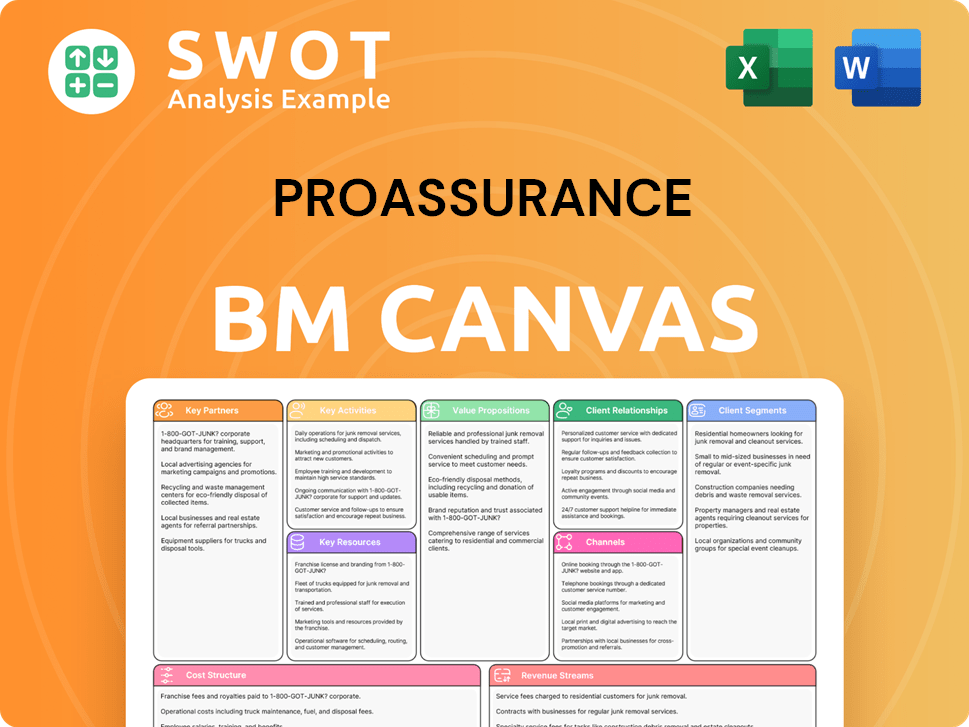
What Recent Changes Have Shaped ProAssurance’s Ownership Landscape?
Over the past few years, the ProAssurance ownership structure has shown stability, aligning with wider industry trends. While there haven't been major share buybacks or significant secondary offerings, the company's consistent performance has likely maintained a solid base of institutional investors. Mergers and acquisitions could lead to ownership changes, but no major events directly impacting the core structure have been reported in this period. Leadership changes, if any, would typically be managed to ensure continuity and minimal disruption to the ownership influence.
Industry trends indicate a rise in institutional ownership across multiple sectors, and ProAssurance is no exception, with major asset managers holding substantial stakes. This can lead to founder dilution over time as companies mature and expand their shareholder base. Activist investors, although not a major factor for ProAssurance recently, can still influence governance and strategic direction. Public statements and analyst reports usually focus on operational performance and financial health, with less emphasis on explicit future ownership changes. Any planned changes would be communicated through official company channels and SEC filings, which currently don't show any immediate dramatic changes to its public ownership structure.
| Metric | Data | Source/Year |
|---|---|---|
| Market Capitalization | Approximately $3.5 billion | Yahoo Finance, May 2024 |
| Institutional Ownership | Around 80% | Nasdaq, May 2024 |
| Insider Ownership | Approximately 1% | Bloomberg, May 2024 |
The company's commitment to financial stability and strategic planning is vital. For further insights into their approach, you can explore the Marketing Strategy of ProAssurance.
Institutional investors hold a significant portion of ProAssurance stock. This indicates confidence from large financial entities. These investors often influence company strategy through their voting power.
Insider ownership, though a smaller percentage, aligns the interests of management with shareholders. This can indicate strong leadership commitment. It shows the leadership's belief in the company's future.
The company's market performance is a key factor in investor confidence. This helps maintain a stable investor base. The financial health of the company is constantly monitored.
The future outlook for ProAssurance depends on various factors, including market conditions. This includes the company's ability to adapt to changing environments. It also relies on strategic decisions and financial performance.
ProAssurance Porter's Five Forces Analysis
- Covers All 5 Competitive Forces in Detail
- Structured for Consultants, Students, and Founders
- 100% Editable in Microsoft Word & Excel
- Instant Digital Download – Use Immediately
- Compatible with Mac & PC – Fully Unlocked
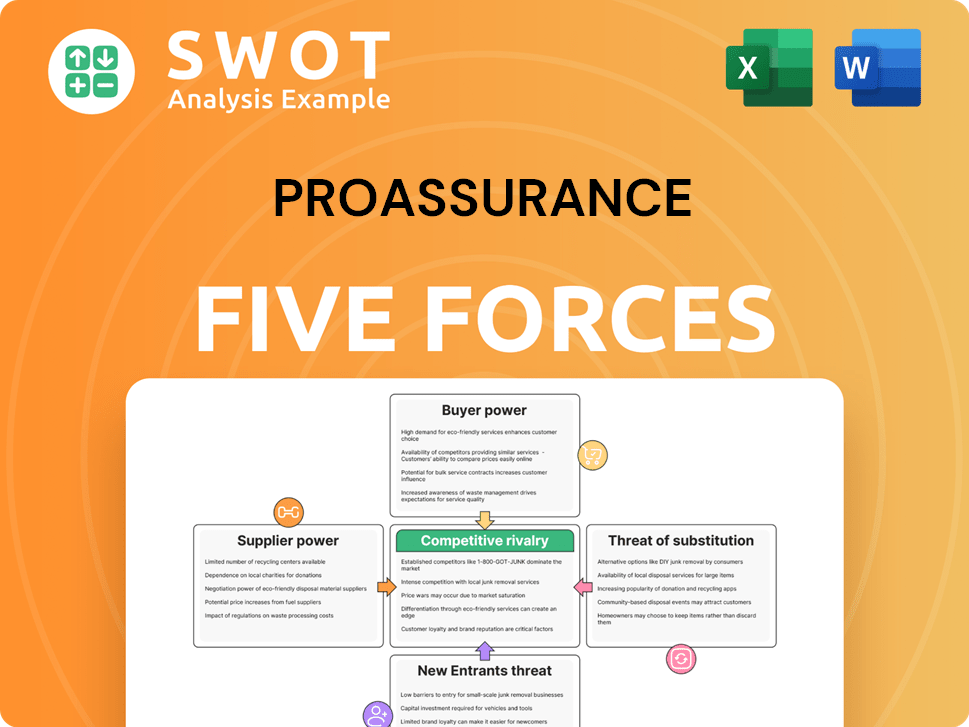
Related Blogs
- What are Mission Vision & Core Values of ProAssurance Company?
- What is Competitive Landscape of ProAssurance Company?
- What is Growth Strategy and Future Prospects of ProAssurance Company?
- How Does ProAssurance Company Work?
- What is Sales and Marketing Strategy of ProAssurance Company?
- What is Brief History of ProAssurance Company?
- What is Customer Demographics and Target Market of ProAssurance Company?
Disclaimer
All information, articles, and product details provided on this website are for general informational and educational purposes only. We do not claim any ownership over, nor do we intend to infringe upon, any trademarks, copyrights, logos, brand names, or other intellectual property mentioned or depicted on this site. Such intellectual property remains the property of its respective owners, and any references here are made solely for identification or informational purposes, without implying any affiliation, endorsement, or partnership.
We make no representations or warranties, express or implied, regarding the accuracy, completeness, or suitability of any content or products presented. Nothing on this website should be construed as legal, tax, investment, financial, medical, or other professional advice. In addition, no part of this site—including articles or product references—constitutes a solicitation, recommendation, endorsement, advertisement, or offer to buy or sell any securities, franchises, or other financial instruments, particularly in jurisdictions where such activity would be unlawful.
All content is of a general nature and may not address the specific circumstances of any individual or entity. It is not a substitute for professional advice or services. Any actions you take based on the information provided here are strictly at your own risk. You accept full responsibility for any decisions or outcomes arising from your use of this website and agree to release us from any liability in connection with your use of, or reliance upon, the content or products found herein.